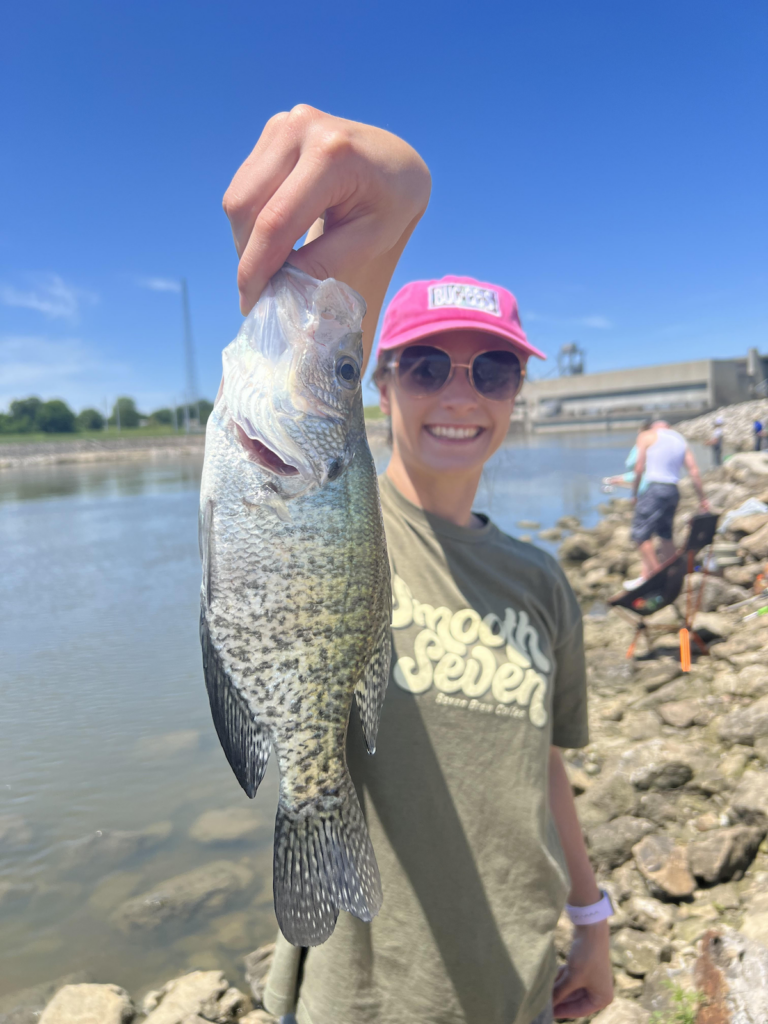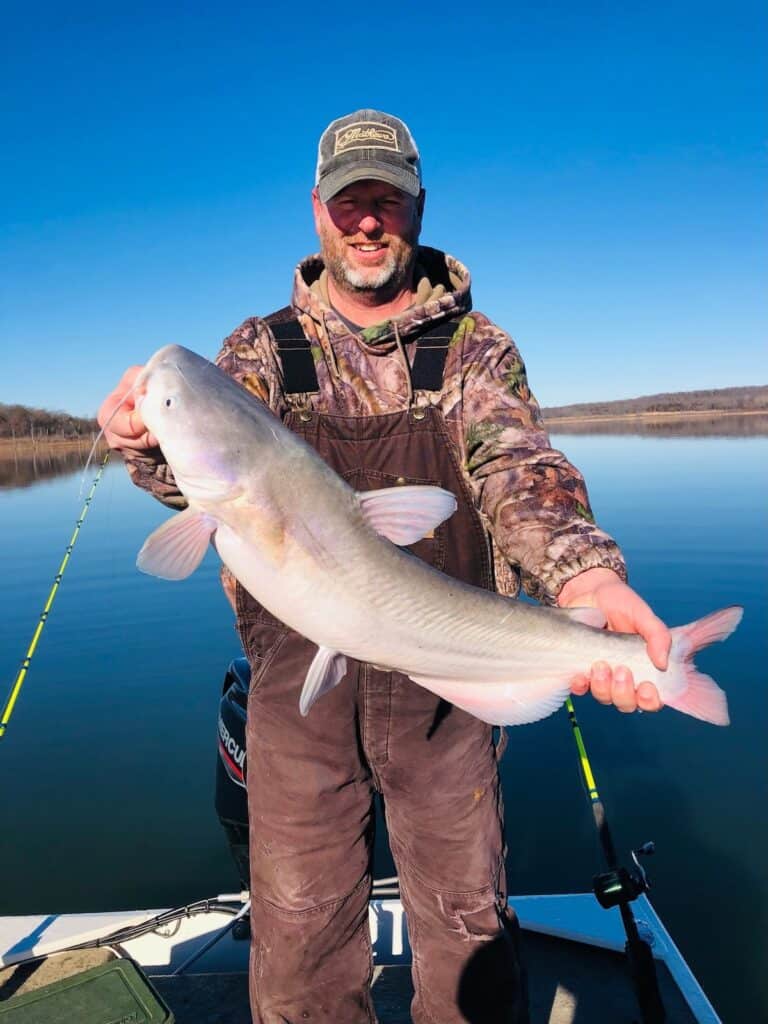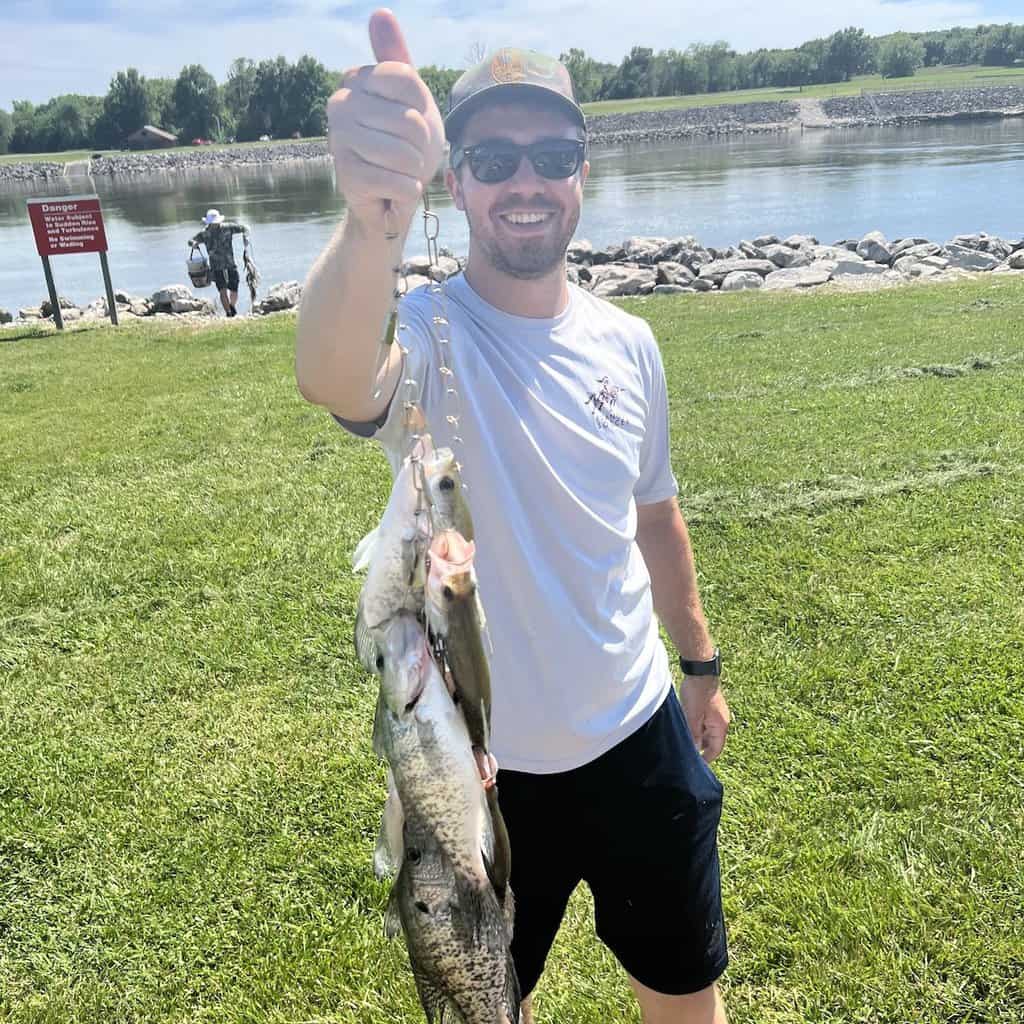Known best for its excellent crappie and bass fishing, Truman Lake consistently ranks as one of Missouri’s best places to fish.
While the bass and crappie might bring anglers to the lake, many other species keep them returning to Missouri’s largest reservoir (over 55,000 acres when full).
As you continue reading, we’ll discuss the species of fish most anglers want to catch, as well as the best ways to land more of them on your next visit to Harry S. Truman Reservoir.
So grab your favorite beverage, kick back, and enjoy learning these Truman Lake fishing tips!
Bass Fishing: Truman Lake Tactics
Bass fishing is the most popular form of fishing across the country, and it’s taken seriously at Truman Lake.
One of the most beneficial tips I’ve learned throughout my years of bass fishing is knowing the spawning cycle of fish.
Catching them is much easier once you understand how bass act during certain times of the year.
For instance, black bass species move into shallow areas with pea gravel bottoms in the spring to make nests and spawn.
Once they’ve spawned, most bass head for deeper waters to feed heavily. These deeper waters aren’t necessarily very far from their spawning areas; they’re often only a few hundred yards away or less.
Most bass spend the summer along ledges in the deeper water, while a few patrol the shoreline, especially in shaded areas.
As summer turns to fall, bass follow their food back to the shallows and feed along flats in preparation for winter.
Once winter sets in, bass spend most of their time in deeper water again. However, they’ll move back to the shallows during warmer stretches.
Now that we have a basic understanding of bass behavior throughout the year, let’s dive into the specifics of the two species found in the Harry S. Truman Reservoir.
Largemouth Bass
Largies dominate the shallows and grow bigger than spotted bass. This is why so many people target largemouth bass while bass fishing.
Their primary food sources are bluegill and shad, so colors that imitate these patterns work best. I love using green pumpkin with a touch of chartreuse to mimic bluegill or anything white or shiny to look like shad.
My favorite largemouth lures are spinnerbaits, jigs, buzzbaits, crankbaits, Texas rigs, and wacky rigs.
The Missouri Department of Conservation (MDC) places brush piles throughout the lake, which are always good places to begin your search for largies.
The shallows of the lower half of the South Grand Arm and the Osage Arm between Talley Bend and Berry Bend are some of the best places to catch largemouth bass at Truman Lake.
Spotted Bass
Spots outcompete largemouth in the open water, so if you want to target spotted bass, you’ll likely need to get offshore and find a creek or river channel.
Spotted bass primarily feed on shad, so chrome and white are excellent color choices. However, that’s not to say they’re the only two colors to use for spots.
I downsize my lures for spotted bass since they have smaller mouths and don’t grow as big as largemouth. My favorite spotted bass lures are spinnerbaits, swim jigs, spooks, drop shots, and swimbaits.
The deeper portions of the South Grand Arm, Osage Arm, Pomme de Terre Arm, and Tebo Arm all hold spotted bass. They’re most abundant in rocky, clearer areas of the lower lake.
Truman Lake Crappie Fishing

Both crappie species abound in Harry S Truman Reservoir and are a massive draw to the lake, especially during the spring spawn. The upper lake tends to have larger crappie while the lower lake has more.
Black crappie tend to prefer the lower portions of the lake because of the clearer water. The Big Tebo area is where you’ll find a ton of black crappie, but they’ll often be on the small side.
Since the Pomme de Terre and Tebo arms and the lower lake have clearer water, you’ll find the highest percentage of black crappie in these areas.
White crappie are most abundant in the murkier water of the upper parts of the lake. The South Grand and Osage Arms are where anglers catch the most white crappie.
However, you can catch both species using the same techniques and bait in similar areas.
The best bait for crappie is live minnows, followed by soft plastic crappie jigs.
For jigs, I recommend using natural and translucent colors in the clearer portions of the lake. In contrast to the murkier waters, I recommend using dark colors including black or bright colors like pink and chartreuse to stand out more.
Trolling over brush piles with small crankbaits is an excellent way to locate a school of crappie without electronics.
Other than the differences in water clarity preferences, black and white crappie have identical spawning patterns.
In the spring, they push shallow in rocky areas to spawn. This early season is the best time of year to fish for them because they’re close to the bank and aggressively feeding.
After they’ve spawned, it’s time to find deep brush piles. You’ll typically want to locate a brush pile in the 20-25-foot range. Depending on the water clarity, you might even need to go as deep as 35 feet during the summer heat.
In the fall, crappies follow their food back to shallow flats to feed before winter and then spend the bulk of the coldest months suspended near channel ledges. However, crappie will patrol shallow flats during warmer winter weather.
Walleye Fishing
There is a healthy population of quality walleye swimming in Truman Lake. However, that doesn’t mean they’re easy to catch.
You might find walleye across the lake, but the best areas are the Pomme de Terre, Sac River, and Upper Osage arms.
We first must understand their spawning cycle to have the best chance of catching the elusive walleye.
Walleye are one of the earliest spawners in the spring, when they make their annual run up the creeks and rivers. During this time, they congregate in deep pools near ripples in the rivers and streams.
In the main lake, riprap banks are the best places to find walleye in the spring.
Once they’ve spawned, walleye head for deep water, searching for their next meal all summer. Their large eyes make them very sensitive to light, so fishing during low-light hours this time of year yields the best results.
As fall sets in, they’ll make another push shallow, following their food. Then it’s back to deeper water for the winter, spending most of their time until the spawn in the river and creek channels.
My color selection for walleye is similar to crappie. I’ve found walleye will key in on bright colors like chartreuse and pink.
I’ve caught walleye on crappie jigs, crankbaits, and soft plastic swimbaits, but the best bait, by far, is live minnows.
Truman Lake Catfish

Truman Lake is one of Missouri’s top catfishing destinations. Catfish are a fan favorite of anyone who likes to eat fish, although for some Truman anglers, catfish don’t quite measure up to crappie and walleye as table fare.
The three catfish species found in Harry S. Truman Reservoir all have a similar spawning cycle, which makes catching them much more straightforward.
Catfish are among the last fish to spawn in late spring and early summer. Unlike other species, this is not the time to fish for them.
Once they’ve spawned in the shallows, catfish head back to deeper holes and ledges, where they feed heavily to pack on the pounds they lost during the spawn. Post-spawn fishing in the summer is one of the best times of the year to go catfishing.
When their food heads for the shallows in the fall, catfish aren’t far behind, but as winter sets in, they move back to spend most of their time in the deep holes.
With that general understanding of catfish behavior, it’s time to talk about how to catch each species.
Catfishing is often done one of three ways: rod & reel, jugging, and set lines (limb lines & trotlines). Be sure to read the regulations to know how many hooks each angler can use.
I approach channel catfish and blue catfish differently than I do flathead catfish. That’s not to say you won’t catch all three in the same area using the same technique, but generally, flathead catfish tend to be the oddballs.
Channel Catfish
Channel catfish are probably the easiest to catch, but they don’t get nearly as big as the other two species. Sometimes they’re misidentified as small blue cats because they have a similar appearance.
When targeting channel cats, I prefer to use live earthworms, chicken liver, stink bait, or small chunks of cut bait. I also downsize my hook to a 6/0, so they have a better chance of fitting it in their mouth.
Channel cats tend to hang out near flats, rip rap banks, and the bridges that cross the lake.
Blue Catfish
Blues are also abundant throughout the lake and found in schools with channel cats, but they grow much larger than channel catfish.
The best baits for blue catfish are large chunks of cut bait and live bait. I prefer to use an 8/0 hook for blues, so they’re less likely to straighten my hook. I also can weed out the smaller fish.
Blues feed on the flats throughout most of the year, so drifting near steep depth changes is usually good. Main lake points, creek mouths, and bridges are some of the best spots to hit when targeting blue cats.
Flathead Catfish
You also might find glatheads throughout Harry S. Truman Reservoir. However, they have slightly different preferences for food and habitat, even though they’re sometimes caught alongside blues and channel cats.
I’ve found live bluegill is the best bait for flatheads, followed by large chunks of cut bait. I still use an 8/0 hook when fishing for flathead catfish because they can grow nearly as big as blue catfish.
Main lake points and flats with standing timber or laydowns are great places to begin. Deepwater Creek, upper Grand, Osage, and Tebo arms of the lake are the best location for flatheads.
Other Fish Species
Here are some other gamefish that perhaps don’t bring the same number of anglers to Truman Lake, but they’re still lots of fun to catch.
White Bass & Hybrid Striped Bass
If I’ve said it once, I’ve said it a million times, I love catching white bass and hybrids. While they’re not the most sought-after fish in the lake, they’re incredibly abundant and can instantly turn a bad day of fishing into an incredible day of fishing.
Hybrids are a cross between white bass and striped bass. They’re stocked in many lakes because they grow bigger than white bass, providing even more exciting angling opportunities.
Even though they’re technically different species, they have identical spawning patterns and are caught side-by-side.
In the spring, white bass (sand bass) and hybrids run up the creeks and rivers to spawn (although hybrids can’t actually reproduce, they go through the motions). This spring run is one of the best times to catch them, as they’re close to the shore and very aggressive.
After they’ve finished their reproductive business, white bass and hybrid stripers head back to creek and river channels and main portions of the lake for the summer. Once their food, primarily shad, heads for the shallow flats in the fall, hybrids and white bass quickly follow.
During the winter, they return to patrolling the main lake’s open waters and deeper holes of the creeks and rivers.
My favorite lures for both species are Mepps spinners, swimbaits, crappie jigs, jigging spoons, and crankbaits.
I’ll troll with crankbaits during the summer until I find an active school. Then I’ll start throwing spinners, swimbaits, or spoons to catch several more fish. In the spring, I tend to catch more using crappie jigs and swimbaits.
Since shad is their primary food source, silver, white, chrome, and translucent colors work the best.
Paddlefish
Paddlefish (a.k.a. spoonbills) are among the most unique fish to swim in Missouri waterways. They’re prehistoric plankton-eating fish without teeth, even though they look similar to sharks for two-thirds of their body length.
Because they don’t eat other fish, you must snag them. Paddlefish snagging season is from March 15 through April 30.
In the spring, they run up the creeks and rivers to spawn and congregate by the hundreds in large pools of the upper Osage arm to the Taberville Access area.
You must follow strict regulations when snagging, so it’s critical to read the rules before heading to the water after paddlefish.
To snag paddlefish, you’ll need a large barbless treble hook, a heavy sinker (2-4 ounces), and a surf rod. Launch the hook and sinker as far as you can and begin ripping and reeling them back to you until you hit a fish.
Then the battle has begun. Hang on for dear life, and always keep the line tight; otherwise, they’ll get away. I recommend hiring a guide if you’ve never snagged before.
Bluegill and Sunfish
A favorite of any angler having a bad day is sunfish. Bluegill and green sunfish are often found along the shoreline of Truman Lake during warmer months, making them the perfect fish for kids and anyone new to fishing.
Live worms on a small hook are the best bait to use for sunfish.
You can catch bluegill and sunfish around docks, grass, rocks, and brush piles. They’re usually so close to the shore or the surface that you can see them, and once you’ve found one, there’s likely many more nearby.
Catch More Bluegill and Sunfish
Check out our simple guide to bluegill and sunfish fishing techniques and more tips.
Planning Your Trip
Now that you’ve gained the knowledge you need to successfully catch many of the species that call Harry S. Truman Reservoir home, it’s time to start planning your trip by becoming familiar with the boat ramps, public access areas, and places to stay.
Boat Ramps & Public Access
Because Truman is such a massive lake, there are many boat ramps and public access areas scattered around it. Here are a few key spots to get you started:
Cooper Creek Public Use Area boat ramp is near Deepwater in the lake’s western arm. It’s a three-lane concrete ramp.
Long Shoal Public Use Area boat ramp is on the north side near mid-lake, off MO-7. This is a two-lane concrete ramp.
Shawnee Bend Access boat launch is just west of the dam, near Shawnee. It’s a six-lane concrete ramp.
Thorny Ridge boat ramp is located mid-lake on the south side and within Harry S. Truman State Park. It’s a two-lane concrete ramp.
There are many other boat ramps and public access areas, so no matter where you stay or which part of the lake you plan on fishing, you’re sure to find water and boat access.
Places to Stay
Whether you prefer the creature comforts of a hotel or becoming one with nature while camping, Truman Lake has plenty of overnight options to offer. There are multiple hotels and motels in Warsaw and Clinton, which are on the east and west sides of the lake, respectively.
Campgrounds abound all over the lake; the most popular is Harry S. Truman State Park, located near the dam.

